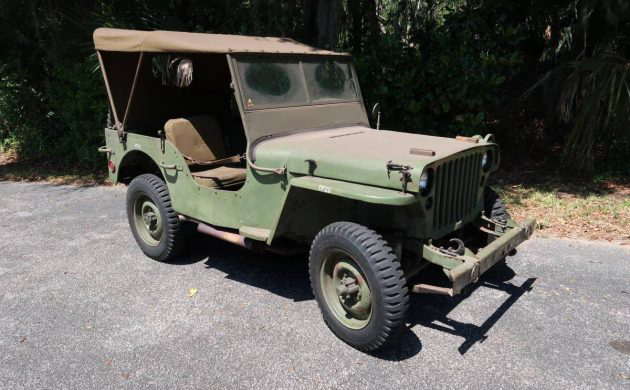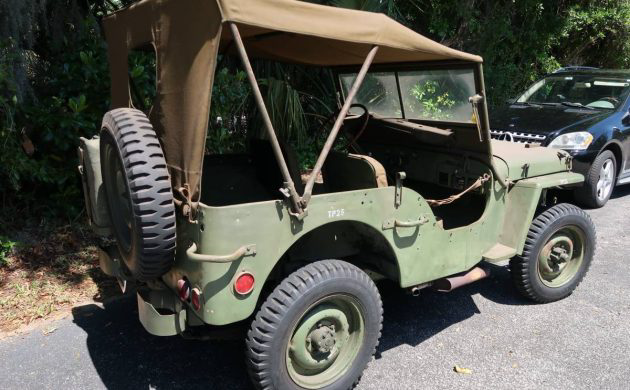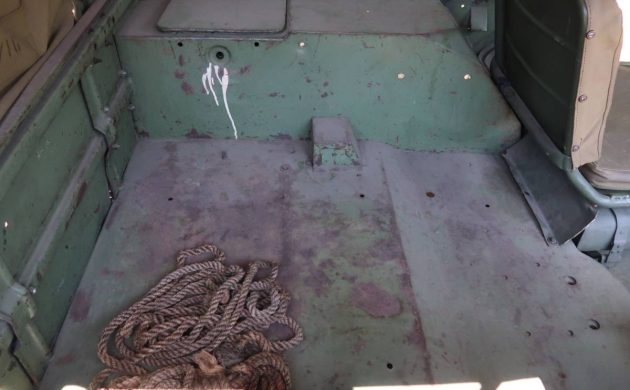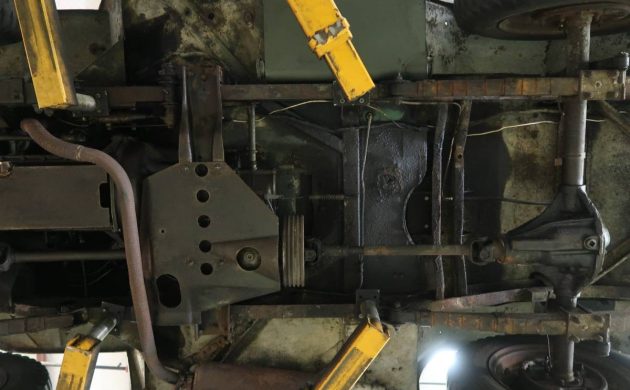Officially going by the name U.S. Army Truck, 1⁄4‑ton, 4×4, Command Reconnaissance, the vehicle we commonly refer to as the Jeep was one of the superstars of World War II. Allowing soldiers, sailors, Marines, and airmen to travel quickly and efficiently to fulfill their duties, the Jeep became synonymous with Americans. If you are looking for an artifact from this great country’s finest hour, then this 1945 Willys MB Jeep for sale on Craigslist in Ormond Beach, Florida is a very authentic example of a true milestone vehicle. Complete with an authentic-looking layer of dust and grime, this Jeep automatically gets you into every hometown parade. It also might give you some insight into what it was like to fight in the greatest war mankind has ever seen. With an asking price of $16,900, do you think this Jeep’s pricing is on the money? Thanks to Randy J. for the tip!
In the study of history, the term primary source roughly means something that is directly connected to the period of history you are studying. For example, the famous photograph of a U.S. Navy sailor embracing and kissing a young lady he didn’t even know in Times Square on VJ (victory over Japan) Day is a primary source for the study of World War II. The picture conveys the overwhelming joy felt when the fighting was finally declared over. Other primary sources for World War II could also be a soldier’s pack, an M1 Garand, or getting that once-in-a-lifetime flight in a B-17, B-24, or B-29 bomber. Using primary sources gets you closer to the event and closer to what people from that period felt, thought, or experienced.
Perhaps one of the best ways to understand a soldier’s life during World War II would be to experience driving and riding in an authentic Jeep. First presented to the U.S. military by the American Bantam Car Company in 1940, the idea of a light, nimble vehicle with four-wheel drive for use on the battlefield was a stroke of genius. This was particularly true in an era where the German Blitzkrieg was changing the face of mechanized warfare by greatly increasing the speed of attacking forces. With World War II participation fast approaching for the United States, it wasn’t long before the rights to manufacture this unique vehicle were given to The Ford Motor Company and Willys-Overland Motors. American Bantam simply didn’t have the resources to allow for the number of vehicles needed after their original orders were satisfied. The three companies would ultimately produce up to 640,000 of these unique vehicles by the time hostilities ceased.
The Jeep you see here is advertised to be unrestored and mostly original by the seller. This is important to Jeep collectors, as they strive to have as authentic a vehicle as possible. Parts getting mixed up with those of other vehicles during overhauls was a common event. After all, all Jeeps tend to look alike, and the parts were almost uniform between Ford and Willys Jeeps. Yet collectors can tell you which parts are correct for the date and serial number of each vehicle. One has to also remember that the Bantam-made Jeeps are fundamentally different and rarely seen in this country due to their low production numbers. Additionally, a large number of them ended up in the USSR as part of Lend-Lease and never returned to the United States.
Regardless of originality, this late-war-produced vehicle is said to run and drive well. The seller also states that it is “fairly reliable.” This may allude to the reason the Jeep has a new fuel pump mentioned in the ad. In addition, the brake fluid has been flushed out and replaced with silicon fluid. With the sale comes the original tools, a canvas top, and many spare parts.
Looking at the pictures reveals a Jeep that looks as if it just rolled off the battlefield. While many Jeeps were left with our allies, several Jeeps were destroyed after the war. There are stories of millions of tons of every resource used in the war being unceremoniously dumped overboard, buried, or sold off for pennies. Jeeps were no exception. Unfortunately, we are told no history whatsoever for this particular Jeep. Perhaps the seller doesn’t know either. Maybe we should just be glad that it survived the war.
In all this seems to be a nice Jeep that would make a wonderful rolling history lesson for today’s Americans. The sacrifices made during World War II are hard for us to comprehend today through our eyes. A primary source like a WWII-era Jeep is a good way to help people understand just how much blood and treasure was sacrificed for them by our ancestors. Hopefully, this Jeep gets sold to someone who respects it as a piece of history and makes an effort to share that history with others.
Do you have any Jeep stories? If so, please share them in the comments.







Many of these were left in the Philippines after the war, and the locals converted them into “Jeepneys”, which served as a very popular taxi service. Anyone who’s been stationed there no doubt rode in one a time or two. And they’ve been modified down through the years, including being stretched into vehicles a whole family can travel in, not to mention power trains being upgraded over and over again. There was no limit to how they were customized. To this day there are still hundreds plying the streets, and most of them run on diesel.
Thanks for that history lesson of WWII. Just so happens I do have a Jeep story although it is a short one. In the late 50’s Army surplus items were sold through various venues. School districts and municipal utility companies were given priority. The water district where I grew up bought a WWII jeep through an auction house in California. In fact I think they bought 2 of them. It was the first time I saw what those things were capable of, we lived in a rural area where roads were rudimentary if they existed at all. There was a 1000 foot high hill at the back of our farm with no roads, but the water district was interested in putting a water supply on top of that hill so the guy that worked in the maintenance department came over to our farm to see if he could get that jeep to climb the hill. It took some doing but he did make it to the top. At about 10 years old I was very impressed with that Jeep. I love these Jeeps but would have no use for one at this point in my life.
God Bless America
Waiting for the first clown to suggest SBC conversion!
already been converted many many times!
Someone really needs to give ‘Sarge’ a bath…
I was lucky enough to drive a Willys WW2 Jeep back about 20 years ago, tons of fun but oh baby you better choose the right line while climbing boulders with stock tires, almost rolled it. Nice write up Jeff.
I attend military vehicle shows every year, and that’s a lot of money for a WWII Jeep with no back story. I’ve seen them in cleaner condition, well appointed with period-correct gear, for considerably less than this guy’s asking price, in the $7000 range and sometimes less.
I lived in the Dutch East Indies as a boy in the early fifties. My father had a Jeep which we drove everywhere. At one time we came across a Python which was lying across a jungle track. I remember my father telling me to brace myself as we were about to drive over the snake which was the size of a log. It stunned the beast and reacted by coiling up in the air resulting it to end up in the back of the Jeep. We sat by the side of the road some distance away waiting for it to vacate the Jeep which took several hours. The snake wasn’t happy!
Thats a gold jeep story!
My first “car” was a ’52 Willys M38 ex fire dept that my Dad and I restored. It was $500 and needed a lot of work. When finished, I learned how to shift the 3 spd manual in the back yard and took the drivers test the next day and passed. I survived sitting on the 12 gal gas tank for 2 years,then got my first new car, ’77 Z28 that cost me $5.2k. Good times! Love to have this MB,just no place to store it.
Sold a GPW just a few years back and it went across the pond to England – hopefully restored for the D-Day activities this year. This is a nice one and one of the harder part or parts are those two piece wheels – most were replaced as they made it through the years.
Went over to my folks house one day in a CJ5. Dad came out, looked at it and said “Glad I didn’t have to try and get that one onboard!!” He then for the first time ever started talking about his WW2 experiences as a pilot flying a Waco CG4A glider, the first trip being into France (St Mere Eglise) 4 hours before the first landings on the beaches of Normandy, 50 miles inside the German lines.
Went on to say that another glider landed near his as they were scrambling to get out (mortar and artillery rounds landing around them). As the other “plane” landed it was hit with a mortar round and the nose, where the pilot and copilot sit, flew up as the shrapnel severed a wire holding it closed. As the pilot and copilot were trying to get out of their seats “a sergeant came flying out past them ‘Hell bent for election’ driving the Jeep they’d hauled in (from inside the the glider) and disappeared down the hedgerow”.
Turns out he’d been a part of all the European Allied glider operations but never felt the need to talk about it to us.
An incredible generation.
Thanks for that and a much better place for war stories than Asian pickups. My dad slogged through the trenches of France( or so it was told), and my FIL went through a lot in the Philippines. While my old man boasted how he and his army buddies urinated on the ruined site of Hitlers speeches, my FIL never, EVER spoke of his service. The atrocities he saw, it was best to block it out. It wasn’t until he met my dad, and began exchanging stories, did it come out.
The Jeep was part of it all, and just speaks freedom sitting still, and why in part, I drive one today.
My father’s (and his friends)1st car. The 20somethings pooled the money & bought the Jeep. It was dirty cheap at the time in post war Athens.